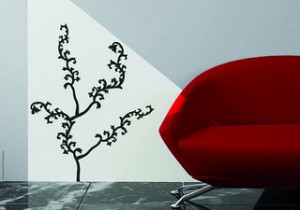Problem solving and creating are two sides of the same coin. If you work, you are doing one or the other. Feeding words and data into a home office computer is neither one of these.

Plain or fancy - a rest area or thinking chair is a productive addition to a home office
In the book Work, Life, Tools by artist and graphic designer Milton Glaser, fifty innovators, creators and artists describe their favorite work tool. The list goes from the tissue to the latest technology, from a No. 2 pencil to the telephone. Sara Little Turnbull, an award-winning Stanford-based design and change innovation consultant states her “resting area” is her favorite tool. The accompanying photo shows her stretched out on a sofa in a corner of her office, like a diva on a divan, staring off into space. “My resting area provides a change of pace, from intense concentration to serenity to objectivity, and to re-examination.” Turnbull takes the time and has created a space in which to “think, imagine, and plan.” A client of mine had me arrange her home office around her office chaise lounge (It was positioned for the best contemplative view out her window.)
John Cleese, actor and writer, states that you must close your laptop to be creative. You must take a break from linear digital tools and allow your brain and your spirit to expand, reflect on patterns and tune into your feelings – feelings that may guide your rational mind in decision-making. (I am reading Jonah Lehrer’s How We Decide; his first statement in the book: decisions are never wholly rational.)
When you work from a home office, you have choices. You can create your own “resting area.” Think of it as a place to de-stress, refresh your brain, gain perspective and do creative/problem-solving daydreaming. Turnbull says her “resting area is a sanctuary that must be visually and purposely integrated in my space.” You may not have room or the desire for a sofa; a comfortable upholstered chair or even a rocking chair may suit you and your space better. I call this “the office reading chair – or the best perk of the home office.” An added benefit to having this reflecting area IN your home office is that you hold on to your train of thought and are less distracted. Turnbull says comfort is an important part of her resting area which allows her “to listen to my inner self and explore new directions ….from a refreshed perspective.”
What kind of “resting area” do you have in your home office? How does it work for you? Share your experience in the comments below. Create one and see if it helps you maintain your working momentum and adds clarity of vision to whatever task or project you are working on.
Just what does Sara Little Turnbull look at when in her “resting area”? On the wall are three posters: one of Chinese calligraphy, a photo of author Isaac Breshevis Singer, and a photo of a blank concrete wall. ;-)
Learn more about how to set-up your home office for productivity, creativity and comfort with my book The Smarter Home Office: 8 Simple Steps to Increase Your Income, Inspiration and Comfort. [link]
Photo by Plage Vinilos y Decoración